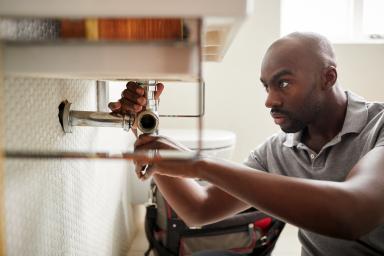How to create a sustainable workplace part 3: staff behaviours
Supercharge the sustainability credentials of your start-up with our guide to how to encourage staff to be more environmentally friendly.
Creating a sustainable workplace encompasses your workspace, your business operations and - crucially - the behaviour of you and your employees.
Staff play a huge role in helping a start-up boost its sustainability credentials and can be valuable advocates in spreading the word to customers about your green activities.
The key to success is recognising that everyone has a role in creating a sustainable workplace.
By involving your team in creating a greener workspace, they'll be able to own the solution and get involved with their ideas.
It may be worth appointing an environment champion who can help coordinate staff activities and keep tabs on progress.
Staff incentives can be instrumental in creating a sustainable workplace, such as rewards for employees who recycle the most.
Even the smallest green act can contribute to a more sustainable workplace, and engage and retain staff who support your start-up's commitment to sustainability.
If you're stuck for ideas to motivate employees to go green, we've rounded up some of the best ideas to get your team involved in creating a more sustainable start-up.
Find out more about how to make your business premises more sustainable in part one, and learn how to transform your business activities to support better sustainable business operations in part two.
Sustainable travel ideas
Travelling to work is a fundamental activity, but it can have serious effects on the environment.
Road transport emission is considered one of the most significant sources of pollution in the UK.
In 2017, greenhouse gas (GHG) emissions from road transport made up around a fifth of the UK's total GHG emissions.
Luckily, there are a few alternative ways staff can travel to reduce CO2 emissions.
1. Choose to cycle or take public transport
Cycling to work is a great way to reduce pollution and can help improve fitness simultaneously, which may result in fewer sick days.
Many businesses are involved in the cycle to work scheme, allowing staff to buy a bike and spread the cost over 12 months.
Another great way to cut down on air pollution is to encourage employees to use public transport.
Although it still emits CO2 into the environment, increased use of public transport means fewer cars on the road emitting CO2.
2. Lift shares
Sharing lifts is a great way to travel to work and reduce emissions.
Not only does it save money for the driver as passengers can share the cost of fuel, but with fewer cars on the road, it can help reduce pollution caused by cars idling when stationary in traffic jams.
Lift sharing is particularly effective when you have several employees living in the same area.
3. Flexible/hybrid working
As the pandemic made working from home more common, implementing a flexible or hybrid working schedule for staff can help reduce emissions.
Allowing staff to work from home can remove unnecessary journeys and lead to lower emissions.
Instead of travelling to meet in person for business meetings, host video conferencing calls to avoid unnecessary journeys.
Environmentally-friendly workplace ideas
Staff can incorporate a variety of steps into their routine at work that may benefit the environment.
1. Recycle
Recycling is one of the easiest ways to help the environment and increase start-up sustainability.
Set up different bins in the office for different types of waste such as glass, cardboard, batteries, toner ink and plastic to encourage staff to recycle.
Install a food waste bin for staff to compost their food waste in kitchen areas.
2. Reuse
Invest in reusable supplies such as refillable water bottles for staff.
The UK uses an average of 150 plastic bottles per person per year.
Adding a water fountain to the office and using refillable bottles can help cut down on plastic waste.
3. Eco-friendly alternatives
Encourage staff to bring lunch from home to avoid unnecessary plastic waste from shop-bought lunches.
Provide staff with reusable containers to bring their lunch in and wax paper sheets as an alternative to clingfilm.
Wooden cutlery, such as bamboo, is better for the environment than plastic cutlery.
Provide sustainably and ethically sourced products, such as toiletries, that avoid toxic chemicals entering the sewage system.
Food waste can be recycled for soil use.
Buying lunch-on-the-go adds up to around 11 billion pieces of packaging a year, so cutting down will help reduce packaging waste significantly.
4. Office plants
Aside from reducing stress, boosting mood and adding to the office interior, indoor plants release oxygen and absorb CO2.
Plants may also be beneficial for reducing noise pollution in the workplace, supporting staff wellbeing.
Encourage staff to use less
Reducing some of our consumption activities can help support the environment.
There are various ways staff can minimise energy use, resulting in few GHG emissions.
1. Energy
The Green Alliance found that UK office buildings waste £60 million in unnecessary energy bills.
Encouraging staff to switch off lights, turn off the water and unplug devices are small steps that can reduce wasted energy over time.
Some old equipment can be replaced with newer, more energy-efficient models to help reduce energy bills - remember to recycle old, unwanted equipment or encourage reuse by other businesses in your local area.
2. Embrace digital
For a more sustainable workplace, avoid needlessly printing documents.
Instead, make documents and files accessible online to reduce paper waste and printer ink consumption - both of which are harmful to the environment.
There are plenty of note-taking apps to utilise in meetings and rather than posting items such as documents and brochures, email or send a link to a digital version if possible.
3. Educate staff that less is more
Encourage staff to create a sustainable workplace with regular training and education sessions.
If staff understand the reason for implementing specific practices, they're more likely to maintain them.
Learning how even the most minor things they do can impact the environment will help them think about ways to incorporate eco-friendly, sustainable practices into their work life and at home.
Learn with Start Up Loans and improve your management skills.
Discover more about managing people with our free online courses in partnership with The Open University on sustainability in the workplace.
Our free Learn with Start Up Loans courses include:
- Effective communication in the workplace
- Managing relationships
- Succeed in the workplace
- Leadership and followership
Plus free courses on climate and sustainability, teamwork, entrepreneurship, mental health and wellbeing.
Disclaimer: The Start -Up Loans Company makes reasonable efforts to keep the content of this article up to date, but we do not guarantee or warrant (implied or otherwise) that it is current, accurate or complete. This article is intended for general information purposes only and does not constitute advice of any kind, including legal, financial, tax or other professional advice. You should always seek professional or specialist advice or support before doing anything on the basis of the content of this article.
The Start-Up Loans Company is not liable for any loss or damage (foreseeable or not) that may come from relying on this article, whether as a result of our negligence, breach of contract or otherwise. “Loss” includes (but is not limited to) any direct, indirect or consequential loss, loss of income, revenue, benefits, profits, opportunity, anticipated savings, or data. We do not exclude liability for any liability which cannot be excluded or limited under English law. Reference to any person, organisation, business, or event does not constitute an endorsement or recommendation from The Start-Up Loans Company, its parent company British Business Bank plc, or the UK Government.
Your previously read articles
Sign up for our newsletter
Just add your details to receive updates and news from Start Up Loans
Sign up to our newsletter


